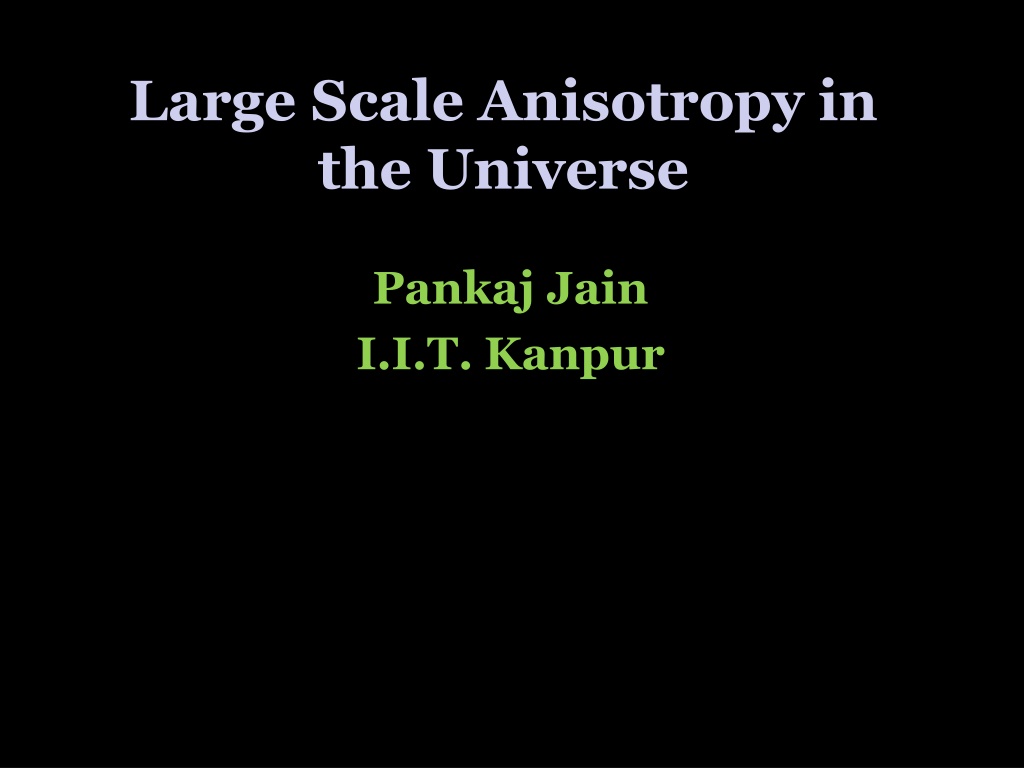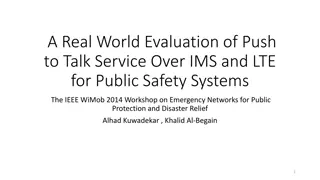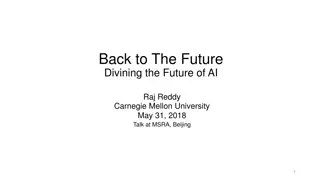
Exploring Large-Scale Anisotropy in the Universe
Discover the concept of large-scale anisotropy in the universe, challenging the assumption of isotropy. Learn about the cosmic frame of rest, inflation in the Big Bang paradigm, and the ongoing debate on isotropy in the universe. Explore the implications of isotropy testing and the uncertainties surrounding inflationary theory.
Download Presentation

Please find below an Image/Link to download the presentation.
The content on the website is provided AS IS for your information and personal use only. It may not be sold, licensed, or shared on other websites without obtaining consent from the author. If you encounter any issues during the download, it is possible that the publisher has removed the file from their server.
You are allowed to download the files provided on this website for personal or commercial use, subject to the condition that they are used lawfully. All files are the property of their respective owners.
The content on the website is provided AS IS for your information and personal use only. It may not be sold, licensed, or shared on other websites without obtaining consent from the author.
E N D
Presentation Transcript
Large Scale Anisotropy in the Universe Pankaj Jain I.I.T. Kanpur
Introduction Universe is assumed to be statistically homogeneous and isotropic at large distance scales No preferred position or direction Cosmological Principle
Cosmic Frame of Rest isotropy applies only in one frame, the cosmic frame of rest In a different frame the background density, temperature display dipole anisotropy due to our local motion
Does not follow from fundamental principle such as translational and rotational symmetries It is justified only by inflation
Big Bang Paradigm Initially Universe may be anisotropic and inhomogeneous Inflation causes a small region to expand exponentially, leading to isotropy and homogeneity Also leads to causal connection of the surface of last scattering
Expect: independent of the initial metric (anisotropic, inhomogeneous) inflation will quickly lead to isotropy and homogeneity But this has been shown only for a limited class of metrics (Wald 1983) Not proved in general On the contrary, Penrose (1989) has shown that this works only for very special cases
Even the limited class of metrics which lead to isotropy allow the possibility of anisotropy on large distance scales (Aluri and Jain 2012, Rath et al 2013)
Furthermore inflation itself is so far not established
We should observationally test isotropy or statistical isotropy Here we restrict ourselves to isotropy since homogeneity is harder to test We already know Universe is isotropic At what accuracy does it apply?
Their exist several observations which appear to violate the cosmological principle Radio source count and sky brightness Radio polarized flux Radio polarizations from radio galaxies Cosmic Microwave Background anisotropies Alignment of optical polarizations from quasars Alignment of radio polarizations and galaxy axes
Testing isotropy in radio surveys At large redshifts (z>0.1) all observables should be statistically isotropic, up to kinematic effects i.e. our motion relative to the cosmic frame of rest
Dipole anisotropy in matter Matter distribution is expected to show dipole anisotropy due to our motion with respect to the cosmic frame of rest Effect seen in NVSS but with larger amplitude direction CMB dipole
One of the science goals of SKA to extract our motion relative to cosmic frame of rest Need to develop a proper data pipeline to extract this effect reliably
Spectral Index S should be isotropic We have tested this using GLEAM catalog Find a significant anisotropy
Spectral Index It may be useful to jointly have an accurate extraction of using uGMRT and ASKAP
Flux Distribution N S x x should be isotropic; tested using NVSS catalog Full sky: x = 0.9939 0.0025 Results consistent with isotropy, deviation roughly 1 signa Should be tested with larger data
Flux per Source Mean flux per source should be isotropic NVSS is consistent with isotropy TGSS deviates from isotropy
Proposal Develop a data pipeline to extract the observables , , flux per source, number counts Interested in the sky distribution of these observables Extract the dipole in number counts which relates to our velocity relative to cosmic frame of rest
Challenges in Testing Isotropy Need to map the sky uniformly Need to control time and direction dependent instrumental bias Need sufficiently large data so that local fluctuations are small Local Universe is not isotropic, so we need to large redshift: But how large? How to remove local sources?
Additional Challenges in extracting local velocity The sky coverage is limited, need to extract dipole from partial sky Need to properly relate dipole to local velocity, depends on assumptions of spectral and flux distribution of sources
Conclusions Theoretical justification for isotropy is weak It should be tested by a dedicated observational survey in several different observables This will also allow an accurate determination of our velocity relative to the cosmic frame of rest
Alignment of radio polarizations and galaxy axis Alignment effect seen on small angular scales Polarization (JVAS/CLASS data) (Tiwari et al) Galaxy axis: GMRT (Taylor and Jagannathan) FIRST catalogue (work in preparation)
Kinematic Dipole Flux density = frequency Sources are distributed isotropically in the cosmic frame of rest N = number counts above some flux limit Slow N (Slow) x
Dipole in Moving Frame An observer in motion relative to the cosmic frame of rest observes a dipole distribution in number counts due to Doppler and Aberration effect. Sky brightness (number counts weighted by flux density) also picks up a dipole
Handling Masked Regions We may extract dipole directly from masked sky masked sky alm = full sky harmonic coefficient
Handling Masked Regions Alternatively, we may fill the masked sky with isotropic source distribution and extract dipole harmonic coefficients directly from the full sky We generate a large number of such full sky maps each filled with different randomly generated data The final result is obtained by taking an average This procedure may lead to some bias which is estimated by simulations
NVSS Masked regions filled
Results (S > 20 mJy) Number of sources = 240772 Bias factors: k = 0.88, = 9.2 deg, DN = 0.0125 0.0040 v = 1000 320 Km/s RA = 159 27 Dec = -15 22 =8.8 deg CMB dipole v = 369 Km/s RA = 167.9 Dec = 6.93
random data
Matter dipole gives a hint of presence of intrinsic dipole This is interesting due to the presence of other effects in the same direction (roughly pointing towards Virgo)
Alignment of radio polarizations at 100 Mpc (supercluster) scale In a galaxy supercluster, the supercluster background magnetic field may induce correlations in the galaxy orientations Radio waves arise due to synchrotron emission. Their polarizations are known to be correlated with the galaxy jet axis Hence polarizations may show alignment on supercluster scale(100 Mpc) (Tiwari and Jain 2015) We use this idea to extract spectral index of intergalactic magnetic field (nB 2.7)
A possible model (class 1) Spontaneous Violation of Isotropy There exists a super horizon mode, i.e. perturbation with wavelength larger than the horizon size. (Gordon et al 2005, Erickcek et al 2008) It might be generated very early during inflation and re-enters the horizon after decoupling. It can lead to alignment of quadrupole and octopole (Gordon et 2005)






















